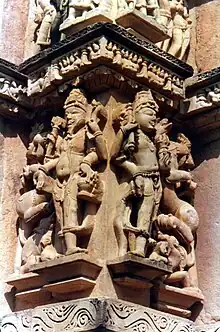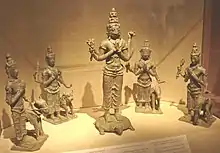
The Guardians of the Directions (Sanskrit: दिक्पाल, Dikpāla) are the deities who rule the specific directions of space according to Hinduism, Jainism and Vajrayāna Buddhism—especially Kālacakra. As a group of eight deities, they are called Aṣṭa-Dikpāla (अष्ट-दिक्पाल), literally meaning guardians of eight directions. They are often augmented with two extra deities for the ten directions (the two extra directions being zenith and nadir), when they are known as the Daśa-Dikpāla. In Hinduism it is traditional to represent their images on the walls and ceilings of Hindu temples. They are also often portrayed in Jain temples, with the exception that Nāga usually takes the place of Vishnu[1] in the nadir. Ancient Java and Bali Hinduism recognize Nava-Dikpāla, literally meaning guardians of nine directions, that consist of eight directions with one addition in the center. The nine guardian gods of directions is called Dewata Nawa Sanga (Nine guardian devata). The diagram of these guardian gods of directions is featured in Surya Majapahit, the emblem of Majapahit empire.
There are strong similarities between the concept of the guardians of the directions and the lore surrounding the Chinese four symbols, four ancestral spirits who are responsible for four of the cardinal directions (North, South, East, and West).
Directions in Hindu tradition

Directions in Hindu tradition are called as Diśā, or Dik. There are four cardinal directions, six orthogonal directions and a total of ten directions, however infinite combinations are possible.
| English | Sanskrit |
|---|---|
| North | Uttara, Udīcī |
| South | Dakṣiṇa, Avācī |
| East | Pūrva, Prācī, Prāk, Aruna |
| West | Paścima, Pratīcī, Aparā |
| Northeast | Īśāna |
| Southeast | Agni |
| Northwest | Vāyu |
| Southwest | Nirṛta |
| Zenith | Ūrdhva |
| Nadir | AdhaH |
Lokapālas
In Hinduism, the guardians of the cardinal directions are called the Lokapālas (लोकपाल), or Dikpalaka.[2] Three main distinctions of Dikpalaka are recognized, being:

Aṣṭa-Dikpāla ("Guardians of Eight Directions")
| Name | Direction |
|---|---|
| Kubera The God of Fortune | North |
| Yama The God of Justice and Death | South |
| Indra The Lord of Heaven and God of the Weather, Sky, Rain, and Storms | East |
| Varuna, God of the Seas, Oceans, and Rain | West |
| Ishana, God of Birth, Death, Resurrection, and Time | Northeast |
| Agni God of Fire | Southeast (In the image incorrectly shown on southwest) |
| Vayu God of the Winds and Air | Northwest |
| Nirṛta God of Death, Sorrow, and Decay[3][4] | Southwest (In the image incorrectly shown on southeast) |
Daśa-Dikpāla ("Guardians of Ten Directions")
Nava-Dikpāla ("Guardians of Nine Directions")

(Called Dewata Nawa Sanga in ancient Java and Bali Hinduism)
See also
Notes
- ↑ Kumar (2001), p. 17.
- ↑ "The Lokapāla: Guardians of the Directions". Medium. September 12, 2019.Retrieved 2023-02-20.
- ↑ Gopal (1990), p. 71.
- ↑ Mani (1975), p. 62.
- ↑ "About Guardians of the directions". 5 May 2020.Retrieved 2023-02-20.
- ↑ "Guardians of The Directions".Retrieved 2023-02-20.
References
- Dallapiccola, Anna (2002). Dictionary of Hindu Lore and Legend. ISBN 0-500-51088-1.
- Gopal, Madan (1990). Gautam, K. S. (ed.). India through the ages. Publication Division, Ministry of Information and Broadcasting, Government of India.
- Kumar, Sehdev (2001). A Thousand Petalled Lotus: Jain Temples of Rajasthan: Architecture & Iconography. Indira Gandhi National Centre for the Arts Series. Abhinav Publications.
- Mani, Vettam (1975). Puranic encyclopaedia : a comprehensive dictionary with special reference to the epic and Puranic literature. Delhi: Motilal Banarsidass.
- Wessels-Mevissen, Corinna (2001). The Gods of the Directions in Ancient India. Origin and Early Development in Art and Literature (until c. 1000 A.D.). Berlin: Dietrich Reimer. ISBN 3-496-02713-4.
External links
![]() Media related to Guardians of the directions at Wikimedia Commons
Media related to Guardians of the directions at Wikimedia Commons
